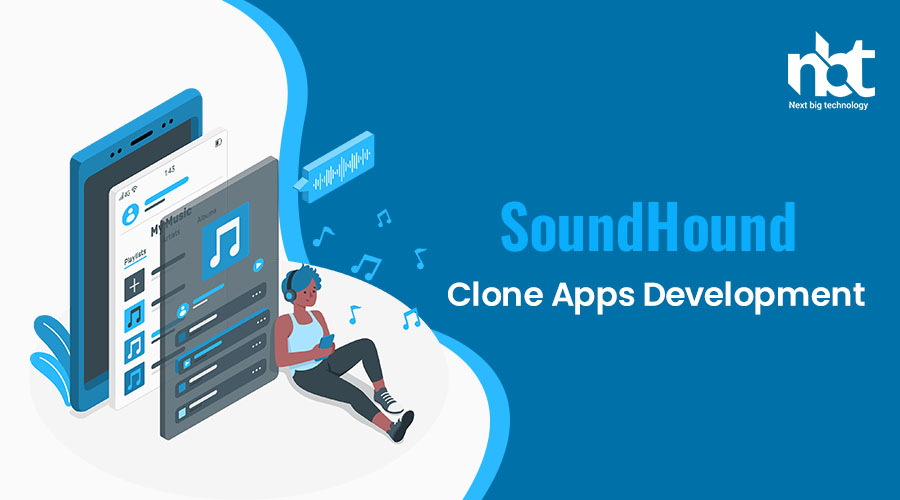Table of Contents
SoundHound Clone Apps Development Services
In the dynamic realm of mobile applications, music recognition has become an integral part of our digital experiences. SoundHound, a pioneering app, has set the standard in this domain, allowing users to identify songs, discover lyrics, and explore new music effortlessly. As the demand for such innovative solutions grows, SoundHound clone app development services have emerged, offering businesses and entrepreneurs the opportunity to create their personalized music recognition applications.
Understanding the Essence of SoundHound Clone Apps:
SoundHound clone apps are custom-built solutions that replicate the core features of the original SoundHound application. These apps leverage advanced algorithms and artificial intelligence to recognize songs, hummed tunes, and even provide real-time lyrics. The development process involves creating a user-friendly interface, integrating robust music recognition technology, and incorporating additional features to enhance the overall user experience.
Key Features of SoundHound Clone Apps:
- Song Recognition Technology: SoundHound clone apps employ cutting-edge algorithms that can identify songs within seconds. Users can simply hum, sing, or type in lyrics to discover the name of the song and the artist.
- Lyric Search and Display: These apps not only recognize songs but also display real-time lyrics, allowing users to sing along or understand the meaning behind their favorite tunes.
- Music Discovery: SoundHound clone apps often come with features to discover new music based on user preferences. This could include personalized playlists, recommendations, and genre-based exploration.
- Offline Mode: To cater to users in various situations, these apps may offer an offline mode, enabling them to identify songs even when they don’t have an active internet connection.
- Integration with Other Platforms: Seamless integration with popular music streaming platforms allows users to directly play recognized songs or add them to their existing playlists.
Benefits of Developing a SoundHound Clone App:
- Customization: Businesses can tailor the app to align with their brand identity and incorporate unique features that cater to their target audience.
- Monetization Opportunities: SoundHound clone apps provide various avenues for monetization, such as premium subscriptions, in-app advertisements, and partnerships with music labels.
- Market Potential: With the rising popularity of music recognition apps, entering this market with a well-developed SoundHound clone app presents significant growth opportunities.
Why Should You Go for SoundHound Clone Apps Development?
In the ever-evolving landscape of mobile applications, the demand for innovative and feature-rich solutions continues to soar. One such trend that has gained considerable traction is the development of SoundHound clone apps. These applications offer a plethora of benefits, making them an enticing choice for both users and entrepreneurs alike.
Understanding the Essence of SoundHound Clone Apps
SoundHound, a renowned music recognition and discovery platform, has set the standard for audio identification technology. By leveraging this concept, developers have created clone apps that emulate the functionalities of SoundHound while introducing unique features and improvements.
1. Unmatched Music Recognition Capabilities: One of the primary reasons to opt for SoundHound clone apps is their exceptional music recognition capabilities. These applications utilize advanced algorithms and extensive databases to identify songs, albums, and artists within seconds. This feature appeals to music enthusiasts who wish to discover and explore new tracks effortlessly.
2. Enhanced User Experience: SoundHound clone apps prioritize an intuitive and user-friendly interface, ensuring a seamless experience for their users. Navigating through the app becomes a breeze, whether users are searching for a specific song, exploring trending tracks, or creating personalized playlists. The emphasis on user experience contributes significantly to the app’s popularity.
3. Customization and Personalization: Unlike generic music apps, SoundHound clones offer a high level of customization and personalization. Users can create personalized playlists based on their preferences, discover curated content, and receive recommendations tailored to their taste in music. This level of personalization enhances user engagement and satisfaction.
4. Integration of Social Features: Social interaction is a key aspect of SoundHound clone apps. Users can connect with friends, share their favorite tracks, and discover music through their social circles. The integration of social features not only enhances the overall user experience but also broadens the app’s reach through social sharing.
5. Entrepreneurial Opportunities: For entrepreneurs considering app development, SoundHound clone apps present a lucrative opportunity. The popularity of music-related applications ensures a ready user base, and the ability to introduce unique features allows developers to stand out in a competitive market. Monetization strategies, such as in-app purchases and premium subscriptions, further add to the app’s revenue potential.
6. Seamless Integration of AI and Machine Learning: SoundHound clone apps leverage artificial intelligence and machine learning to continually improve their music recognition capabilities. These technologies enhance the accuracy of song identification and enable the app to adapt to users’ evolving preferences over time.
Market Prospects of SoundHound Clone Apps Development and Platforms
In recent years, the mobile app development industry has witnessed a surge in demand for music recognition applications, with SoundHound standing out as a pioneer in this domain. The success of SoundHound has paved the way for the development of clone apps, creating new opportunities in the market. This article delves into the market prospects of SoundHound clone apps development and the platforms driving their growth.
Understanding the SoundHound Phenomenon:
SoundHound, a popular music recognition app, has gained immense popularity for its ability to identify songs by analyzing hums, lyrics, or snippets of tunes. The success of SoundHound lies in its intuitive interface, accurate recognition algorithms, and a vast database of songs. Entrepreneurs and developers have taken notice, leading to the emergence of SoundHound clone apps.
Market Prospects:
- Growing Demand for Music Recognition: As music continues to be an integral part of people’s lives, the demand for innovative ways to discover and identify songs is on the rise. SoundHound clone apps cater to this demand by offering similar functionalities, providing users with an alternative to traditional music streaming services.
- Diversification of Features: Developers are enhancing SoundHound clone apps by integrating additional features. These may include personalized playlists, social sharing options, and even augmented reality components. The diversification of features adds value to the user experience, attracting a broader audience.
- Entrepreneurial Opportunities: The success of SoundHound has opened up entrepreneurial opportunities for developers and business enthusiasts. Launching a SoundHound clone app can be a lucrative venture, especially with the right marketing strategy and a unique selling proposition.
- Global Accessibility: SoundHound clone apps contribute to the globalization of music discovery. With multilingual support and the ability to recognize songs from various cultures, these apps have the potential to reach a global audience, further expanding the market prospects.
Platforms Driving Growth:
- iOS and Android: The majority of SoundHound clone apps are developed for both iOS and Android platforms, ensuring a wide user base. Leveraging the app stores of these platforms allows developers to tap into diverse audiences and maximize visibility.
- Integration with Smart Devices: SoundHound clone apps are increasingly being integrated with smart devices such as smart speakers and wearables. This integration enhances user convenience, making it possible for users to identify songs seamlessly using voice commands or gestures.
- Collaborations with Music Streaming Services: Collaborations between SoundHound clone apps and established music streaming services create synergies. By allowing users to seamlessly transition from identification to full streaming, these apps can enhance user retention and engagement.
Essential Features of a SoundHound Clone Apps Development
In the realm of music discovery and identification, SoundHound has carved a niche for itself by providing an innovative and user-friendly platform. As the demand for music-related applications continues to surge, the development of SoundHound clone apps has gained significant traction. These clones aim to replicate the success of SoundHound by offering users a similar experience with unique features. In this article, we will delve into the essential features that developers should consider when creating a SoundHound clone app.
- Advanced Audio Recognition Technology: The core functionality of a SoundHound clone revolves around audio recognition. Implementing advanced audio recognition technology ensures that the app can accurately identify songs, even in noisy environments. The incorporation of machine learning algorithms enhances the app’s ability to recognize diverse music genres and styles.
- Comprehensive Music Database: A robust and expansive music database is crucial for a SoundHound clone. It should encompass a wide range of songs, including the latest releases and timeless classics. Regular updates to the database will keep the app relevant and ensure users can identify even the most obscure tracks.
- Real-Time Lyrics Display: To enhance the user experience, real-time lyrics display is a feature that shouldn’t be overlooked. Users can follow along with the lyrics while listening to a song, creating a more immersive and engaging experience. This feature sets the SoundHound clone apart from other music identification apps.
- Integration with Streaming Platforms: To stay competitive, a SoundHound clone should seamlessly integrate with popular music streaming platforms. This integration allows users to not only identify songs but also stream them instantly. APIs from platforms like Spotify, Apple Music, or YouTube can be leveraged for a seamless streaming experience.
- Voice Recognition and Control: Implementing voice recognition technology allows users to interact with the app using voice commands. This hands-free functionality enhances user convenience, making the app accessible while driving, working out, or in other situations where manual input may be challenging.
- User-Friendly Interface: A clean and intuitive user interface is vital for the success of any music app. Users should be able to navigate effortlessly, access features easily, and enjoy a visually appealing design. Customizable settings and personalized recommendations contribute to a positive user experience.
- Offline Mode: Enabling offline mode allows users to identify and save songs even when they don’t have an internet connection. This feature is essential for users who want to identify songs in areas with poor connectivity or during travel without consuming excessive data.
- Social Media Integration: Facilitating social sharing enhances the app’s virality. Users should be able to share their music discoveries, favorite tracks, and playlists on social media platforms. This integration can also be leveraged for collaborative playlist creation and music-related social interactions.
Advanced Features SoundHound Clone Apps Development
In the dynamic realm of mobile applications, the demand for cutting-edge technology and innovative features continues to soar. Among the plethora of applications, music recognition apps have gained immense popularity, with SoundHound standing out as a pioneer in the field. As technology evolves, the development of SoundHound clone apps has become a trend, with developers integrating advanced features to enhance user experience. In this article, we will delve into the world of advanced features in SoundHound clone app development that promises to revolutionize the way we interact with music.
- Voice Command Integration: One of the standout features in advanced SoundHound clones is the incorporation of voice command technology. Users can simply speak out the name of the song, artist, or lyrics, and the app will instantly recognize and fetch the relevant information. This hands-free functionality adds a layer of convenience and elevates the overall user experience.
- Augmented Reality (AR) Music Identification: Imagine pointing your phone’s camera at a live performance or a music poster, and the app not only recognizes the music playing but also provides additional details such as upcoming concerts, artist information, and related content. AR technology takes music identification to the next level, creating an immersive and interactive experience for users.
- Real-time Lyrics Display: Building on the foundation of traditional music recognition, advanced SoundHound clones now offer real-time lyrics display. As the music plays, users can follow along with the lyrics on their screens, enhancing the connection between the listener and the song. This feature caters to both karaoke enthusiasts and those who simply want to sing along with their favorite tunes.
- Playlist Customization and Collaboration: A key advancement in SoundHound clone apps is the ability to create personalized playlists effortlessly. Users can curate their music collections based on moods, genres, or activities. Additionally, some apps go beyond solo playlist creation, allowing users to collaborate on playlists with friends, and fostering a sense of shared musical experiences.
- Integration with Smart Home Devices: To complement the smart home trend, advanced SoundHound clones seamlessly integrate with popular smart home devices. Users can control music playback using voice commands through devices like Amazon Echo or Google Home, extending the app’s functionality to the broader ecosystem of connected devices.
- AI-driven Music Recommendations: Leveraging the power of artificial intelligence, SoundHound clone apps now provide highly personalized music recommendations. By analyzing user preferences, listening habits, and contextual data, the app suggests new songs and artists, introducing users to a diverse range of music tailored to their tastes.
SoundHound Clone Apps Development Timelines
In the fast-paced world of mobile applications, creating a SoundHound clone app has become an enticing venture for developers aiming to provide users with a unique and immersive audio discovery experience. This article will delve into the development timelines of SoundHound clone apps, exploring the key phases and considerations to ensure a seamless and successful project.
Understanding the Concept:
Before diving into the development process, it’s crucial to comprehend the core features of SoundHound. SoundHound, a popular music recognition app, allows users to identify songs by simply humming or singing into their devices. The clone app aims to replicate this functionality while potentially adding unique features or improvements.
- Research and Planning (Weeks 1-2): The initial phase involves thorough research to understand the market, user expectations, and potential challenges. Identifying the target audience and analyzing competitors can provide valuable insights. Developers must also outline the app’s features and functionalities during the planning stage, ensuring a clear roadmap for the entire development process.
- Design and Prototyping (Weeks 3-6): Creating an intuitive and visually appealing user interface is paramount. During this phase, designers work on wireframes and prototypes, ensuring a seamless user experience. Feedback from potential users can be incorporated into the design, refining the app’s look and feel.
- Development (Weeks 7-16): The development phase involves coding the app based on the finalized design. Developers will focus on integrating the music recognition algorithm, ensuring accuracy and speed. Additionally, features such as user profiles, search functionality, and social sharing options will be implemented. Frequent testing is essential to identify and rectify bugs promptly.
- Testing and Quality Assurance (Weeks 17-20): Rigorous testing is crucial to ensure the app functions flawlessly across various devices and operating systems. This phase involves both manual and automated testing to identify and address any performance or compatibility issues. Quality assurance ensures that the app meets the highest standards before its release.
- Deployment (Weeks 21-22): Once the app has passed all tests and quality checks, it’s ready for deployment. Developers will launch the app on selected platforms, such as the App Store and Google Play. Careful coordination is required to ensure a smooth release, and developers should be prepared to address any post-launch issues swiftly.
- Post-Launch Support and Updates (Ongoing): The journey doesn’t end with the app’s release. Developers need to provide continuous support, address user feedback, and promptly resolve any issues. Regular updates should also be planned to introduce new features, improvements, and security patches.
How Much Does It Cost to Build a SoundHound Clone App Development?
In the ever-evolving landscape of mobile applications, music recognition apps have gained significant popularity. SoundHound, a pioneering player in this space, has set a high standard with its advanced features and seamless user experience. Entrepreneurs and businesses looking to capitalize on this trend often inquire about the cost involved in developing a SoundHound clone app. In this article, we will delve into the key factors influencing the cost and provide insights into the overall investment required for a successful SoundHound clone app development.
Understanding the Features: Before delving into the cost estimation, it’s crucial to outline the features that make SoundHound a standout app. A typical music recognition app should include fundamental functionalities such as audio recognition, song identification, lyrics display, and playlist creation. Additionally, advanced features like voice commands, integration with popular streaming platforms, and social sharing capabilities contribute to the overall user experience.
Development Team Composition: The cost of developing a SoundHound clone app is inherently tied to the expertise and location of the development team. Hiring a skilled team that includes project managers, developers, designers, and quality assurance professionals is essential for a successful project. The development team’s location is also a critical factor, as labor costs vary significantly across regions.
Technology Stack: Choosing the right technology stack is pivotal in determining the app’s performance, scalability, and overall user satisfaction. The development team must select the appropriate programming language, framework, and database system. Additionally, integration with third-party APIs for music databases and streaming services will impact the overall development cost.
User Interface (UI) and User Experience (UX) Design: A visually appealing and user-friendly interface is imperative for the success of any mobile application. Investing in skilled UI/UX designers is essential to create an intuitive and engaging interface that enhances the user experience. The cost of design will depend on the complexity of the app’s layout, graphics, and animations.
Testing and Quality Assurance: Thorough testing and quality assurance are crucial to ensure the app’s functionality, security, and performance. The testing phase involves identifying and fixing bugs, conducting usability testing, and ensuring the app is compatible with various devices and operating systems. The cost of testing is a significant component of the overall development budget.
Post-Launch Maintenance and Updates: Once the app is launched, ongoing maintenance and updates are essential to address user feedback, fix bugs, and introduce new features. Allocating a budget for post-launch support is vital to ensure the app’s long-term success and user satisfaction.
How to Create a SoundHound Clone App Development – Team and Tech Stack
In the dynamic world of mobile applications, creating a clone of a popular app like SoundHound requires meticulous planning, a skilled team, and a carefully chosen tech stack. This article will guide you through the essential steps involved in developing a SoundHound clone, focusing on assembling the right team and selecting an optimal tech stack for seamless app development.
Building Your Development Team:
- Project Manager: To kick off your SoundHound clone app development, appoint a proficient project manager. This individual should possess strong organizational skills, excellent communication abilities, and a solid understanding of the app’s objectives.
- UI/UX Designers: Engage creative UI/UX designers who can craft an intuitive and visually appealing interface. The success of your app heavily relies on a user-friendly design, so invest time in creating a seamless user experience.
- Frontend Developers: Skilled frontend developers will bring the designers’ visions to life. Ensure they are proficient in the latest technologies and frameworks for mobile app development, such as React Native or Flutter.
- Backend Developers: The backbone of your SoundHound clone lies in the backend development. Experienced backend developers should be proficient in server-side languages like Node.js, Python, or Ruby, and should have a strong grasp of database management systems.
- Mobile App Developers: Hire developers who specialize in iOS and Android app development. These experts should be adept at working with the chosen development frameworks and have a deep understanding of mobile app architecture.
Selecting the Right Tech Stack:
- Programming Language: Opt for a language that aligns with your team’s expertise and the app’s requirements. Python and Node.js are popular choices for backend development, while languages like Swift (iOS) and Kotlin/Java (Android) are commonly used for mobile app development.
- Framework for Backend Development: Choose a robust framework for backend development. Express.js, Django, or Flask are popular options that offer scalability and efficiency.
- Database Management System: Select a reliable database management system based on your project’s needs. MySQL, PostgreSQL, or MongoDB are commonly used for mobile app development.
- Frontend Framework: For frontend development, consider using React Native or Flutter. These frameworks allow for cross-platform development, saving time and effort in building separate codebases for iOS and Android.
- API Integration: SoundHound relies heavily on music recognition and integration with external databases. Ensure seamless API integration for features like song identification and lyrics retrieval.
SoundHound Clone App Development Process
In the ever-evolving landscape of mobile applications, music discovery and recognition apps have become a prominent player, offering users a seamless way to identify and enjoy their favorite tunes. SoundHound, a pioneer in this domain, has set a benchmark with its innovative features and user-friendly interface. If you’re considering delving into the world of app development and wish to create a similar experience, understanding the SoundHound clone app development process is crucial.
- Market Research and Analysis: The journey begins with a comprehensive market analysis to identify the target audience, their preferences, and the competitive landscape. Understand the unique selling points of SoundHound and its competitors to carve out a niche for your clone app.
- Defining Features and Functionalities: Once armed with market insights, outline the key features and functionalities you want your app to offer. SoundHound’s success lies in its ability to not only identify songs but also provide lyrics, recommendations, and integration with streaming services. Tailor these aspects according to your target audience’s needs.
- Technology Stack: Selecting the right technology stack is crucial for the performance and scalability of your app. Consider factors such as platform (iOS, Android, or both), backend infrastructure, database, and third-party APIs for music recognition and streaming.
- User Interface (UI) and User Experience (UX) Design: Craft an intuitive and visually appealing UI that ensures a seamless user experience. Focus on simplicity, easy navigation, and incorporate SoundHound’s signature elements while maintaining a unique identity for your app.
- Backend Development: The backend is the engine that powers your app. Develop a robust backend infrastructure to handle user data, song databases, and API integrations. Ensure scalability to accommodate future growth.
- Music Recognition Algorithm: Implement a powerful music recognition algorithm that can accurately identify songs from audio snippets. This is a core feature, and the success of your app hinges on the reliability and speed of this functionality.
- Lyrics Integration: If your goal is to emulate SoundHound’s all-encompassing approach, integrate a lyrics feature. Collaborate with lyric databases and ensure accuracy in providing real-time lyrics to enhance user engagement.
- Recommendation Engine: Enhance the user experience by incorporating a robust recommendation engine. Analyze user preferences and behavior to offer personalized song recommendations, creating a more immersive experience.
- Integration with Streaming Services: Allow users to seamlessly transition from identification to playback. Integrate popular streaming services to provide users with the option to listen to full tracks, thereby enhancing overall user satisfaction.
- Testing and Quality Assurance: Thoroughly test the app for functionality, performance, and security. Conduct beta testing with a select group of users to gather feedback and make necessary improvements.
- Deployment and Marketing: Once satisfied with the testing phase, deploy the app to the respective app stores. Develop a comprehensive marketing strategy to create awareness and attract users to your SoundHound clone.
- User Feedback and Continuous Improvement: Encourage user feedback and actively seek ways to improve your app. Regularly update the app with new features, optimizations, and bug fixes to stay relevant in the competitive landscape.
Next Big Technology – Your Trusted SoundHound Clone App Development Partner
In a world driven by technological advancements, the demand for innovative and user-friendly applications continues to soar. As we usher in the era of the next big technology, the role of sound recognition apps has become increasingly significant. One such pioneering solution is the SoundHound clone app, a powerful tool that opens up a realm of possibilities for users across various domains. In this article, we will explore the immense potential of this technology and guide you in choosing a reliable development partner for creating your customized SoundHound clone.
The Rising Significance of Sound Recognition Apps:
Sound recognition technology has evolved from being a niche concept to a mainstream application with a wide range of uses. From identifying songs and music to detecting environmental sounds, the possibilities are endless. The SoundHound clone app, inspired by the renowned SoundHound application, takes this technology to new heights. Users can not only discover music but also leverage the app for voice commands, voice searches, and even sound-based authentication.
Features that Set SoundHound Clone Apps Apart:
- Advanced Music Recognition: The primary feature of a SoundHound clone app is its ability to identify songs accurately and instantaneously. Whether you’re at a party or watching TV, the app ensures you never miss out on the name of a catchy tune.
- Voice-Enabled Commands: Taking inspiration from virtual assistants, the SoundHound clone app allows users to control their devices through voice commands. This feature enhances the user experience by providing a hands-free and intuitive interface.
- Customizable Solutions: A reliable SoundHound clone app development partner understands the importance of customization. They should be able to tailor the app to meet the specific needs and branding of their clients, ensuring a unique and seamless user experience.
Choosing the Right Development Partner:
When it comes to creating a SoundHound clone app, selecting the right development partner is crucial for success. Here are some key factors to consider:
- Experience and Expertise: Look for a development team with a proven track record in creating sound recognition applications. Experience in working with similar projects will ensure a smoother development process.
- Technological Proficiency: The next big technology requires cutting-edge skills. Ensure that your development partner is well-versed in the latest advancements in sound recognition, artificial intelligence, and mobile app development.
- Client Testimonials and Reviews: Explore the feedback from previous clients to gauge the reliability and performance of the development partner. Positive testimonials are indicative of a trustworthy and competent team.
- Cost-Effective Solutions: While quality is paramount, a reputable development partner should also offer cost-effective solutions. Request a detailed quote and assess the value they bring to the table about the investment required.
Enterprise SoundHound Clone App Development
In the rapidly evolving landscape of technology, voice-enabled applications have become the cornerstone of innovation, transforming the way we interact with our devices and systems. One such groundbreaking technology is SoundHound, a voice-enabled platform that has redefined the possibilities of voice interaction. Enterprises looking to capitalize on this trend are now exploring the development of their own SoundHound clone apps, seeking to create a seamless and intuitive user experience. In this article, we delve into the intricacies of Enterprise SoundHound Clone App Development, exploring its potential, key features, and the steps involved in bringing this cutting-edge technology to life.
Understanding the Essence of SoundHound
Before diving into the development process, it’s crucial to comprehend what makes SoundHound a game-changer in the realm of voice-enabled applications. SoundHound goes beyond conventional voice recognition, offering a comprehensive solution that includes music identification, voice search, and natural language understanding. Its ability to recognize and respond to complex queries has made it a favorite among users seeking a sophisticated and efficient voice interaction experience.
Key Features of Enterprise SoundHound Clone App
- Music Identification: Just like SoundHound, the clone app should be adept at identifying songs based on user humming, singing, or providing snippets of lyrics. Implementing an extensive music database and advanced algorithms is essential for accurate identification.
- Voice Search Capability: The app should enable users to perform voice searches across various domains, providing relevant and precise results. Natural language processing (NLP) plays a pivotal role in enhancing the accuracy and user-friendliness of the voice search feature.
- Multilingual Support: To cater to a diverse user base, incorporating multilingual support is imperative. The app should seamlessly recognize and respond to queries in different languages, ensuring inclusivity and accessibility.
- Integration with Third-Party Platforms: To enhance user engagement, the clone app should integrate with popular third-party platforms, such as music streaming services, navigation systems, and smart home devices. This integration extends the app’s functionality and makes it a central hub for various voice-activated tasks.
Steps in Enterprise SoundHound Clone App Development
- Market Research: Conduct a thorough analysis of the target audience, competitor landscape, and emerging trends in voice-enabled applications. This research forms the foundation for creating a unique and competitive clone app.
- Define Features and Functionalities: Based on the research findings, outline the key features and functionalities that the clone app will offer. Ensure that these align with the expectations of the target audience and address any gaps identified in the market.
- Technology Stack Selection: Choose the appropriate technology stack for your app, considering factors such as scalability, security, and compatibility with the desired features. Leverage robust frameworks and tools to streamline the development process.
- User Interface (UI) and User Experience (UX) Design: Craft an intuitive and visually appealing UI/UX design that enhances the user’s interaction with the app. Prioritize simplicity and clarity in design to create a seamless user experience.
- Development and Testing: Implement the chosen technology stack to develop the app, ensuring that each feature is meticulously coded. Conduct rigorous testing at each stage to identify and address any bugs or performance issues.
- Integration of AI and NLP: Integrate advanced AI algorithms and natural language processing capabilities to enhance the app’s ability to understand and respond to user queries accurately.
- Multilingual Support Implementation: Incorporate multilingual support to cater to a global user base. This involves not only language recognition but also providing relevant responses in the user’s preferred language.
- Third-Party Integration: Integrate the app with popular third-party platforms to broaden its functionality and utility. Ensure seamless interoperability with music streaming services, navigation systems, and other relevant applications.
- Security Measures: Implement robust security measures to safeguard user data and ensure the privacy of voice interactions. Encryption and secure authentication protocols are critical in this regard.
- Launch and Marketing: Once the app has undergone thorough testing and quality assurance, launch it on the desired platforms. Develop a comprehensive marketing strategy to promote the app and attract users.
Top SoundHound Clone App Development Companies
In today’s rapidly evolving technological landscape, music recognition apps have become a popular choice among users. SoundHound, with its advanced audio recognition capabilities, has set a benchmark in the industry. If you’re considering developing a similar app, you’ll want to collaborate with the best SoundHound clone app development companies. In this article, we’ll delve into the top players in the field, highlighting their unique features and contributions to the app development sphere.
-
-
Next Big Technology:
Next Big Technology is one of the top development companies for the high-quality development of mobile apps and web development services. They have having experienced in-house team of developers who provide top-notch development services according to the business requirements. NBT provides highly business-oriented services and implements all the latest and trending tools and technologies. They always work hard to deliver a top-notch solution at an affordable cost. They are having experience of more than 13 years and delivered lots of projects around the globe to businesses and clients.
NBT is highly focused on providing top-notch development solutions at a very affordable cost. By using their market experience and development experience, they are delivering proper solutions to clients and various industries for their custom requirements.
Location: India, USA, UK, Australia
Hourly Rate :< $25 per Hour
Employees: 50 – 249
Focus Area
- Mobile App Development
- App Designing (UI/UX)
- Software Development
- Web Development
- AR & VR Development
- Big Data & BI
- Cloud Computing Services
- DevOps
- E-commerce Development
Industries Focus
- Art, Entertainment & Music
- Business Services
- Consumer Products
- Designing
- Education
- Financial & Payments
- Gaming
- Government
- Healthcare & Medical
- Hospitality
- Information Technology
- Legal & Compliance
- Manufacturing
- Media
-
- MindInventory: MindInventory is synonymous with cutting-edge technology and trendsetting app development. Specializing in clone app development, they have successfully crafted SoundHound clones that boast seamless audio recognition and an intuitive user experience. Their commitment to staying ahead in the tech curve makes them a reliable partner for your project.
- Code Brew Labs: Code Brew Labs is a name synonymous with creativity and excellence. Their adept team of developers is well-versed in crafting SoundHound clones that not only replicate the original’s features but also introduce innovative enhancements. With a client-centric approach, Code Brew Labs ensures that your app stands out in the competitive market.
- Hidden Brains: Hidden Brains has earned its spot among the top SoundHound clone app development companies through its commitment to delivering scalable and secure solutions. Their development process involves a meticulous understanding of client requirements, resulting in apps that exceed expectations in terms of performance and reliability.
- Cubix: Cubix has carved a niche for itself in the app development arena, particularly in creating clones of popular applications. Their SoundHound clones are a testament to their technical prowess, featuring advanced audio recognition algorithms and a sleek user interface. Collaborating with Cubix ensures a product that aligns perfectly with your vision.
FAQs on SoundHound Clone App Development
SoundHound, a renowned music discovery and identification app, has set the benchmark in the industry. Entrepreneurs seeking to capitalize on this success are turning to SoundHound clone app development to create their music-centric applications. As the demand for such apps grows, so does the curiosity surrounding their development. In this article, we delve into the frequently asked questions (FAQs) on SoundHound clone app development to provide a comprehensive understanding for aspiring developers and businesses.
- What is a SoundHound Clone App?A SoundHound clone app is a custom-built application inspired by the features and functionalities of the original SoundHound app. It allows users to identify songs, discover new music, and enjoy various audio-related features.
- How Does Sound Recognition Technology Work?Sound recognition technology, a crucial component of SoundHound clone apps, utilizes advanced algorithms to analyze and match audio patterns. This technology identifies songs by comparing the captured sound snippet with an extensive database of audio fingerprints.
- What Features Can Be Integrated into a SoundHound Clone App?A SoundHound clone app can include features such as song identification, lyrics display, artist information, music recommendations, and even social sharing capabilities. The choice of features depends on the specific goals and target audience of the app.
- Is Licensing Required for Music Recognition?Yes, integrating music recognition functionality requires obtaining the necessary licenses from music copyright holders. This is a crucial legal step to ensure compliance with intellectual property rights and avoid legal repercussions.
- Which Technologies Are Ideal for SoundHound Clone App Development?Developing a SoundHound clone app involves using technologies like machine learning, artificial intelligence, and cloud computing. These technologies enable accurate sound recognition and seamless user experiences.
- How Can User Privacy Be Ensured?Implementing robust data protection measures, including secure data storage and user consent features, is essential to guarantee user privacy. Compliance with data protection regulations is paramount in SoundHound clone app development.
- What Monetization Strategies Are Effective for SoundHound Clone Apps?Monetizing options include in-app advertisements, premium subscription models, and partnerships with music streaming services. Choosing the right strategy depends on the app’s target audience and the perceived value of its features.
- How Long Does It Take to Develop a SoundHound Clone App?The development timeline varies based on the complexity of features, design, and the chosen technology stack. On average, it may take several months to create a fully functional and polished SoundHound clone app.
- What Challenges May Arise During Development?Challenges may include obtaining music licenses, ensuring accurate sound recognition in various environments, and addressing potential copyright issues. Experienced developers can navigate these challenges effectively.
- How to Market a SoundHound Clone App Successfully?Effective marketing strategies include leveraging social media, collaborating with influencers, and optimizing the app store presence. Offering a unique value proposition and engaging with the target audience is key to success.
Thanks for reading our post “SoundHound Clone Apps Development”. Please connect with us to learn more about the SoundHound Clone Apps.























